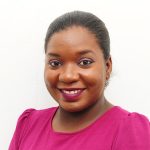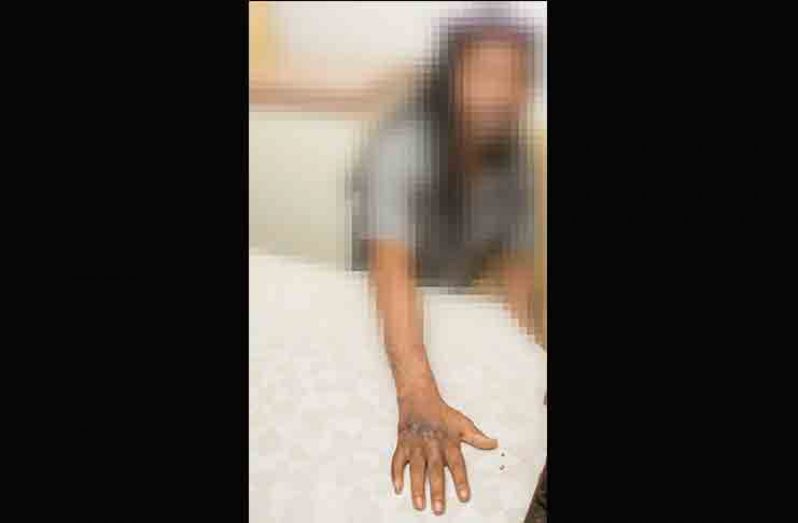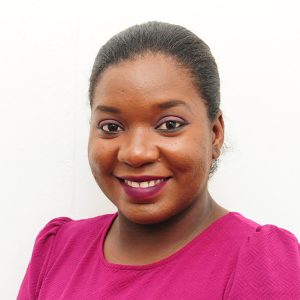By Svetlana Marshall
Leprosy is not curable.
It is a disease that can be caught by simply touching someone who is affected. It causes your fingers, toes and limbs to drop off; it is a curse handed down by God for past sins.
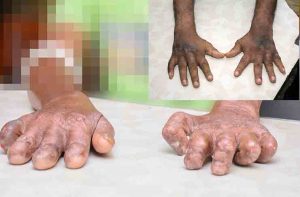
None of the above is true, but these myths associated with leprosy have been around for generations past and persist today and serve to compound treatment for those affected.
The fact is that leprosy can be cured and does not pass on from one human to the other as easily as the myths suggest.
The World Health Organisation (WHO) describes leprosy as a chronic disease caused by a slow multiplying bacillus or a rod-shaped bacterium called Mycobacterium leprae.
Due to the nature of the disease, which is also known as the Hansen’s disease, it is transmitted via droplets from the nose and mouth during close and frequent contacts with untreated cases, WHO explained.
However, it takes approximately five to eight years to develop while symptoms can take as long as 20 years to appear.
If left untreated, it causes nerve damage in three main areas of the body – the face, hands and feet.
As such, the sensory and motor functions within these areas are compromised and may result in the inability to feel and or move the parts of the body that are affected.
In 2000, the disease, which dates back to the Biblical days, was eliminated as a public health problem globally with a prevalence of less than one case per 10, 000 persons, according to WHO.
Official figures from 138 countries from six WHO regions show the global registered prevalence of leprosy to be at 176, 176 cases at the end of 2015.
During the same year, 211, 973 new cases were reported, WHO stated on its official website.
Here in Guyana, leprosy is not a public health threat, as the country has achieved the elimination target of less than one case per 10, 000 persons. However, there are persons living with the disease in the country.
Forty-year-old Arjoon (not real name) is among the small batch of Guyanese diagnosed with the disease.
Arjoon believes that he may have contracted the disease as a child but it was only in his mid-20s while working the Barbados that he realised that something was terribly wrong.
“I used to sit with my hands to my knee, and eventually, I found that the knee started getting numb, and start getting a think flesh, never use to feel no pain at all,” he recalled.
He subsequently sought medical attention but after more than three years of undergoing treatment for a “perceived infection,” Arjoon migrated to St. Maarten, where he changed jobs and sought further medical help.

It was in St. Maarten that Arjoon was told by a doctor that he may have leprosy. By then, he was experiencing additional symptoms, including discolouration of the skin, fever, rashes and boils about the body.
In 2011, he returned to Guyana, after it had proven difficult for him to acquire the required treatment in St. Maarten.
However, it took him some years before he was referred to the Public Health Skin Clinic by a private doctor. It was there that he was diagnosed with leprosy by the doctors operating out of a building in the compound of the Palms Geriatric Home on Brickdam in the capital city Georgetown.
Currently on the Multidrug Therapy (MDT), Arjoon said he is on the road to recovery. “The knee, it got back better. Two weeks now the boils started coming on my face, but other than that I am normal, normal. But when it come up on me, the pain makes you cry like a baby,” he said.
The team of doctors and nurses at the Skin Clinic, were able to treat Arjoon before the disease could have further developed, hence Arjoon has little or no disability.
However, Daniel (not real name), another patient at the Public Health Skin Clinic, was not so fortunate. Though cured, he is battling with the deformities that come with the disease during its latter stages.
For many years, he had noticed a discoloration in his skin but the thought of leprosy had never crossed his mind, maybe “lota” but never leprosy.
There were times when those pale spotted areas on his body would become numb but it was something he had taken for granted up until 2010 when he became severely ill while working in the fishing industry.
For three years he consulted with private medical practitioners and was repeatedly told that he was experiencing “kidney failure.” His ill health had cost him his job.
The father of one had opted to drive for another company, but before he knew it, he was out of a job for a second time after continuously vomiting blood and developing ulcers on his hands. “I end up going at West Dem Regional Hospital, and they detected it and refer me to the Skin Clinic,” he said.
Eventually, in 2010 Daniel was diagnosed with leprosy by the doctors at the Skin Clinic.
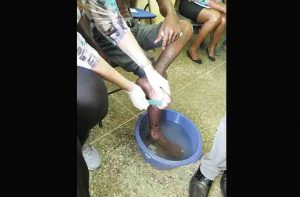
Cured
After more than two years of undergoing treatment at the government run skin clinic, Daniel has been cured of leprosy. However, he was cured at a time when the disease had significantly advanced, resulting in deformity. Due to the loss of tissue, his fingers and toes have become shortened and deformed.
“On the left side of my foot I have no toes. On the right side the toes are shortening, and I have ulcers on all two foot. I have an ulcer on my elbow – the bone actually is out and so you don’t have to ask about the pain, it is terrible,” he explained while sitting in the building that houses the Skin Clinic.
Now, he is advising persons to know the symptoms associated with leprosy. “If you see any mark, any mark, and you know you haven’t gotten a scratch from somewhere but you seeing a discolouration or feeling numbness about your body, seek public medical attention now.
“If I had gotten this diagnosis early, maybe, maybe, I would have still had my toes, and my fingers would not have been shortening,” he said.
Daniel is among the millions that have been cured from leprosy after undergoing MDT. In fact, more than 14 million leprosy patients have been cured over the last 20 years, according to a booklet on the Guidelines for the Control of Leprosy in Guyana which was published in November 2013.
Discrimination
Though Daniel has been cured and receives the support of his immediate family, he is ever so often discriminated against in public spaces and even by his own relatives.
“Everywhere you turn…you go to the market, people look at you and turn up there face, and walk away.
“I was in a bus one day, and a guy look at me and said I looked like an alligator and passed me and went down to the back of the bus. And when he came out, he turned to the conductor and said I looked like I have AIDS,” Daniel said as he broke down in tears.
“I have been discriminated against by my own brother. He doesn’t even look in my direction.
“Since I got sick, he turned his back on me,” he added as he tried to fight the tears from flowing.
The neglect and discrimination experienced by Daniel has caused him to develop a love for animals, mainly chickens. “I have no friends. I have no friends.
“I need company but even when I go to buy chicken feed, I am discriminated against. One time this woman laughed at asked if I had AIDS.”
Head of the National Leprosy Control Programme, Dr. Nikita McKenzie, who manages the Skin Clinic, said removing the stigma and discrimination surrounding leprosy remains an uphill task for health workers not only in Guyana but across the world.
Contrary to popular beliefs, Dr. Mckenzie said leprosy is not a curse that causes parts of the body to fall off; rather, it is a curable disease that cannot be transmitted by simply touching someone with leprosy.
“It is not one of the diseases that you should fear. It is curable,” she emphasized while explaining that within days of being treated the patient can no longer transmit it.
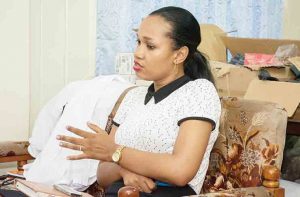
Know the facts
Instead of putting up a barrier, Dr. McKenzie believes that Guyanese should become knowledgeable about the disease.
“It is a disease that affects all organs except the brain, the lung and the spinal cord. It affects every other area. It can go from just the skin patches to the raised infiltrated skin lesions all the way up to the infiltrated areas of the face, such as cheek bone. It could also cause flattening of the nose bridge, loss of eye brows, hair loss to the eye lashes. It can also cause blindness if complications get so far, if left untreated leprosy,” she explained.
However, if detected during its early stages, Dr. McKenzie said the many of the deformities could be prevented or even reversed.
In an effort to raise greater awareness, detect and treat patients, Dr. McKenzie with the help of Dr. Lorraine Katon, five nurses and a medical technologist attached to the skin clinic and by extension the National Leprosy Control Programme, has been conducting outreaches in several regions in addition to the weekly clinics held at the Palms.
Clinics are also held monthly in Skeldon, Port Mourant and New Amsterdam in Region Six; and at the West Demerara Regional Hospital and Parika Health Centre in Region Three. The team also visits the Lodge, David Rose, Grove and Soesdyke Health Centres in Region Four, in addition to the Linden Hospital Complex in Region 10.
During these outreaches, Dr. McKenzie and team look for the usual signs, and once a diagnosis is made, the patient is placed on a six month or one year treatment plan depending on the severity of the disease.
The treatment is a Multidrug therapy (MDT), which has been made available by WHO free of charge to all patients worldwide since 1995. However, some patients for varying reasons either refuse the medication or stop taking it abruptly – decisions Dr. McKenzie strongly advises against.
It was noted too that once a leprosy patient is identify, family members who have been in close and constant contact with the individual are screened.
“But we not only examine the patient but family members and persons who have been in close contact with the patient because leprosy is not a disease of the person but of the family…Once a family member is showing signs we treat them as well, and cure them of the disease before it could even advance,” she explained.
As of September, 2016 the programme registered approximately new 31 cases, and according to Dr. McKenzie the “numbers are still going up.” The youngest patient is six-years old and the oldest 64.
It was pointed out that in 2015, 29 new cases were recorded, 28 in 2014, 25 in 2013, 16 in 2012, 23 in 2011 and 26 in 2010. Between 1996 and 2009, the lowest number of new cases (21) was recorded in 1996 while the highest (53) was recorded in 2003.
“From the population that we have been able to reach, as in part of Regions Three, Four, Six, Five and 10, Region Six has been showing to have a lot of cases,” Dr. McKenzie pointed out while noting too that due to the frequency in which clinics are held in Georgetown, a high number of cases also originate from Region Four.
The country’s Chief Medical Officer, Dr. Shamdeo Persaud has also expressed concern about the rising number of cases.
“We were averaging about 22 per year, but this year it has bounced up back a little bit and we noticed some newer and younger people who are also affected, and many of the cases have links to the older cases,” Dr. Persaud explained.
As such, maintaining surveillance around the contacts such as immediate members within the family is important, he said.
Guyana, however, is experiencing some limitation in its quest to combat the disease, the CMO said, explaining that specially trained technicians to do the smears are needed.
“There are two types. There is a multibacillary form of leprosy where you can easily identify the organism, and then there is a paucibacillary which is harder to detect. So the skill of the technician is very important to identify these cases,” he explained.
And so to complement the work of the skin clinic, the National Leprosy Control Programme with technical support from the Pan-America Health Organisation (PAHO) hosted a training programme last September to develop the capacities of health care workers to detect, treat and manage leprosy.
The one week training session, which attracted participants from Regions Four, One, Seven, Eight and Nine, was facilitated by US Occupational Therapist Linda Lehman and Leprologist Dr. Jaison Barreto of Brazil with the support of local doctors.
Minister of Public Health, Dr. George Norton said the 20 healthcare workers who attended the training are now better positioned to detect, treat and manage cases of leprosy, and also prevent and or minimize impairments in the identified regions.
He said the training forms part of a movement by the Public Health Ministry to bring the country in line with Global Leprosy Strategy 2016-2020.
The strategy, themed, “Accelerating towards a leprosy-free world,” aims to revive efforts for leprosy control and to avoid disabilities, particularly among children affected by the disease.
It focuses on the need to sustain expertise and increase the number of skilled leprosy staff, to improve the participation of affected persons in leprosy services, and to reduce visible deformities – also called grade-2 disabilities (G2D). Removing the stigma associated with the disease, is also key on the agenda.




.png)

